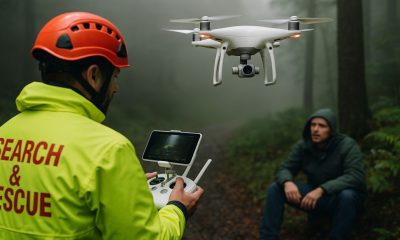Japanese Drone Regulations
Japanese Regulations by Drone Class
Published
8 months agoon
Table Of Contents

Japanese Regulations by Drone Class – What are they?
The Japanese Regulations by Drone Class categorize drones based on their weight and intended use, with each class having specific rules and requirements to ensure safe and compliant operations. Whether operating micro drones for recreational purposes or larger drones for commercial and industrial applications, understanding the Japanese Regulations by Drone Class is crucial for maintaining compliance with safety standards and legal guidelines set by the Ministry of Land, Infrastructure, Transport, and Tourism (MLIT). Each class has tailored operational limits and safety requirements that drone operators must follow to ensure responsible and lawful drone use.
Micro Drones (Below 200g)
Definition
Micro Drones are those that weigh less than 200 grams. These lightweight drones are primarily used for recreational purposes and pose minimal risk to people and property.
Regulations
- No Registration Required: Micro Drones do not need to be registered with the Ministry of Land, Infrastructure, Transport, and Tourism (MLIT) for recreational use. However, operators must still follow basic safety rules.
- Operational Limits: Micro Drones must adhere to the general operating rules, such as maintaining visual line of sight (VLOS), avoiding restricted areas, and not flying over crowds or in no-fly zones.
- Altitude Limit: The maximum allowable altitude for Micro Drones is 150 meters above ground level.
- No Night Operations: Flying Micro Drones at night is prohibited unless special permission is obtained.
Typical Use Cases
- Recreational Flying: Hobbyist flying in open spaces such as parks or backyards.
- Indoor Use: Safe to fly indoors due to their small size and lightweight design.
Small Drones (200g to 25kg)
Definition
Small Drones weigh between 200 grams and 25 kilograms. These drones are commonly used for both recreational and commercial purposes, including photography, surveying, and industrial inspections.
Regulations
- Mandatory Registration: All Small Drones must be registered with MLIT. The registration process includes providing detailed information about the drone and paying a registration fee.
- Remote Pilot License (RPL): For commercial operations, operators must hold a Remote Pilot License (RPL) to demonstrate that they have the necessary knowledge and skills for safe drone operation.
- Operational Limits: Small Drones must adhere to the same operational limits as Micro Drones, including altitude restrictions, VLOS requirements, and avoiding restricted areas.
- Insurance Requirement: Commercial operators must have liability insurance to cover any potential damages or injuries caused during operations.
Typical Use Cases
- Aerial Photography and Videography: Capturing images and videos for commercial or personal use.
- Agricultural Monitoring: Using drones to monitor crop health, soil conditions, and livestock.
- Infrastructure Inspection: Inspecting bridges, power lines, and other infrastructure for maintenance and safety.
Large Drones (Above 25kg)
Definition
Large Drones weigh more than 25 kilograms and are typically used for specialized commercial and industrial applications, such as long-range deliveries, complex surveying, and large-scale environmental monitoring.
Regulations
- Certification and Licensing: Operators must obtain comprehensive certifications, including a Remote Pilot License (RPL) and a Remote Operator’s Certificate (ROC). The drone itself must also meet stringent certification standards similar to those for manned aircraft.
- Operational Authorization: Operators must apply for an Operational Authorization from MLIT, which involves submitting a detailed safety and risk assessment plan. This is necessary for high-risk operations, such as flying in controlled airspace or conducting BVLOS missions.
- Insurance Requirement: Due to the high-risk nature of large drone operations, comprehensive insurance coverage is mandatory to cover potential liabilities.
- Advanced Safety Measures: Large Drones must be equipped with advanced safety features, such as automatic collision avoidance systems, redundant communication systems, and emergency recovery mechanisms.
Typical Use Cases
- Long-Range Cargo Delivery: Transporting goods over long distances, particularly in remote or hard-to-reach areas.
- Environmental and Wildlife Monitoring: Conducting large-scale environmental surveys, wildlife monitoring, or disaster assessments.
- Industrial Applications: Performing complex inspections and maintenance tasks in industrial settings, such as oil rigs, wind farms, and large-scale construction sites.
Drone Classes and Their Impact on Operations
Understanding the specific regulations for each drone class is crucial for planning safe and compliant operations in Japan. Operators must choose the appropriate class based on their intended use and ensure they meet all the necessary requirements for registration, licensing, and insurance.
Summary
Understanding and adhering to Japanese Regulations by Drone Class is essential for safe and legal drone operations. By following the specific rules and requirements for each class, operators can ensure that their activities comply with safety standards and legal guidelines set by the Ministry of Land, Infrastructure, Transport, and Tourism (MLIT). Complying with Japanese Regulations by Drone Class not only minimizes risks but also contributes to a safer and more organized airspace, supporting the responsible use of drone technology across various applications.
To Learn more about acronyms used in this article visit our Drones Acronym Page.











